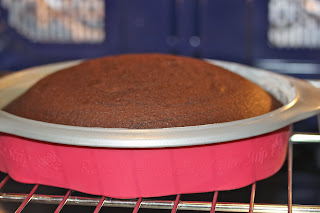I had an extra orange hanging around, so that got me thinking about how to use it. I was feeling a little bored with my usual rotation of cookies for the treat drawer, so I got out Rose's Heavenly Cakes by Rose Beranbaum and started browsing for a chocolate cake to go with the orange frosting. She is considered one of the premier cake bakers in the country, appearing on Top Chef, etc. What I love about her book is that she completely deals with the measurement issues by offering all of the alternatives. Not only does she list the volume measurements, both sifted and scoop and level, but she also gives the weight in ounces and grams. You just have to pick one and stick with it and the proportions will be right. I opted for the grams because they are generally more precise, but I will list all four (!). Rose believes that the best way to create a light cake is to minimize the amount of time that the wet ingredients interact with the flour, decreasing the time for gluten to form (remember, gluten makes things chewy). While classically many cakes started with creaming butter and sugar, then alternating wet and dry ingredients, she starts with the dry ingredients in the bowl, then adds the fats, then the wet ingredients. It's a little different, and as I try different recipes, I'll let you know what I think about the results.
Cakes fall into categories, based somewhat on the fats used. There are butter cakes, oil cakes, sour cream and oil cakes, etc. This cake, which she calls a chocolate layer cake, is made with mostly butter, but a little bit of oil. I appreciate that this recipe makes a single layer, so we won't be overwhelmed with leftover cake.
One of Rose's other preferences is for something called cake strips. These are a form of insulation around the cake pan to try to even out the baking. They look like this:
About cocoa powder: there are basically two types, alkalized and non-alkalized. For baking, it is preferable to use alkalized because it has been treated with a mild alkali to mellow its flavor by neutralizing acidity and that makes it more soluble. Sometimes I use ScharffenBerger, but here I used King Arthur Flour's Double-Dutch Dark Cocoa.
CHOCOLATE LAYER CAKE
1/2 cup plus 1 Tablespoon or 1.5 oz or 42 g unsweetened (alkalized) cocoa powder
1/2 cup (4 fluid ounces) boiling water
2 large eggs, at room temperature
3 Tablespoons (1.5 fluid ounces) water
1 1/2 teaspoons pure vanilla extract
1 1/2 cups plus 1 Tablespoon sifted (or 1 1/3 cups packed) or 5.5 ounces or 156 g AP flour
1 cup or 7 ounces or 200g superfine sugar
2 teaspoons baking powder
1/2 teaspoon salt
8 Tablespoons or 4 ounces or 113 g unsalted butter at room temperature
2 Tablespoons or 1 oz canola oil
Special Equipment: one 9x2-inch round cake pan, encircled with a cake strip, bottom coated with shortening, topped with a parchment round, then coated with baking spray with flour.
Preheat oven to 350 degrees F, with the oven rack set in the lower third of the oven.
Mix the cocoa and water: In a medium bowl, whisk the cocoa and boiling water until smooth.
Cover with plastic wrap to prevent evaporation and cool to room temperature, about 30 minutes.
Mix the remaining liquid ingredients: In another bowl, whisk the eggs, the 3 Tablespoons of water, and the vanilla just until lightly combined.
Make the batter: In the bowl of a stand mixer fitted with the flat beater, mix the flour, sugar, baking powder and salt on low speed for 30 seconds. Add the butter, oil, and cocoa mixture.
Mix on low speed until the dry ingredients are moistened. Raise the speed to medium and beat for 1 1/2 minutes. Scrape down the sides of the bowl.
Starting on medium-low speed, gradually add the egg mixture in two parts, beating on medium speed for 30 seconds after each addition to incorporate the ingredients and strengthen the structure. Scrape down the sides of the bowl.
Using a silicone spatula, scrape the batter into the prepared pan and smooth the surface evenly with a small offset spatula.
Bake the cake: Bake for 27 to 30 minutes, or until a wire cake tester inserted in the center comes out almost clean and the cake appears cooked in the center. The cake should start to shrink from the sides of the pan only after removal from the oven.
As you can see, despite the cake strip, this cake had a pronounced dome. However, when it cooled, it came right down and was quite even.
Let the cake cool in the pan on a wire rack for 10 minutes. Run a small metal spatula between the sides of the pan and the cake, pressing firmly against the pan, and invert the cake onto a wire rack that has been lightly coated with nonstick cooking spray. To prevent splitting, reinvert the cake so that the top side is up. Cool completely.
ORANGE FROSTING
1/2 cup or 4 ounces unsalted butter
1 lb confectioner's sugar
3-4 Tablespoons freshly squeezed orange juice
grated rind of 1 orange
1/2 teaspoon orange oil
Combine all ingredients in mixing bowl.
Using the whisk attachment, start to slowly whip the frosting until the sugar and liquids have mixed, then mix on highest speed. Check after a few minutes to see if the frosting is a good spreading consistency. Then whip it for another 5 minutes to get a light, easy to spread frosting.
I use my cake dome for frosting, because it turns easily on the countertop.
You will probably have extra frosting, but wouldn't you rather have too much than too little?
Voila!















No comments:
Post a Comment